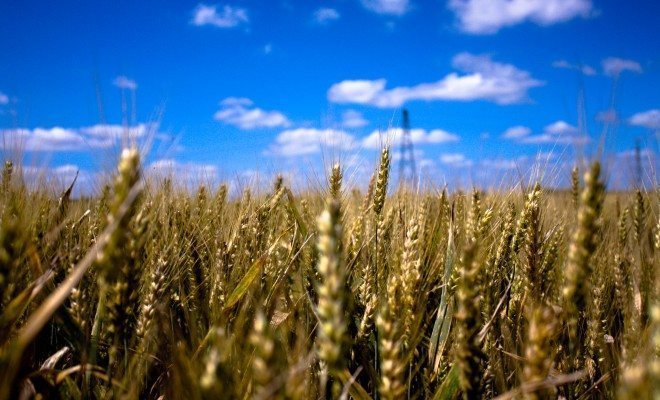 Image courtesy of [Kevin Lallier via Flickr]
Image courtesy of [Kevin Lallier via Flickr]
Health & Science
How to Regulate Gluten, the Modern Food Villain
Imagine ripping into a warm baguette with your bare hands. You owe its intoxicating fluffiness and delectable chewiness to gluten. A water insoluble protein found in wheat, gluten and its compounds bring us everything we expect from bread. It helps dough rise and hold its shape while also lending elasticity, making bread deliciously chewy.
Yes, we’re talking about the same gluten that has become a modern villain, misunderstood and widely hated. Popular books like “Wheat Belly and Grain Brain: The Surprising Truth About Wheat, Carbs” and “Sugar—Your Brain’s Silent Killers” turned gluten into poison in the public eye. Testimonials extolling the virtues of a gluten-free diet crusade the internet, converting many a faithful bread eater. In short, few foods have gained as much notoriety as gluten and many people think it equals anything bad in food.
Far from evil, gluten just presents a digestive challenge. When you digest wheat, the proteins break down into peptides with compact and complicated structures that cause adverse reactions in people with conditions like Celiac Disease, wheat allergies, or IBS. Unfortunately, in the past 60 years these conditions have become more common, stumping manufacturers and regulators who struggle to satisfy growing market demand for safe, gluten-free products. Read on to find out what they’ve done about gluten, and what they still have to figure out.
The anti-gluten craze: trend or reality?
Is gluten-hatred just a viral trend that people flock to like lemmings? Or is there some truth behind the gluten hate?
Scientifically, aspects of gluten-hatred hold water. Celiac Disease has quadrupled in the last 60 years. Celiac Disease is a disorder triggered by gluten that causes intestinal problems and poor absorption of vitamins and minerals.
Unfortunately, these statistics don’t point to an explanation, leaving scientists to toss around possible theories like darts. Some point the finger at wheat-breeding practices, others insist modern processing plays a part. At this point, only more well-controlled studies on the subject will lead to a consensus.
One study ruled out the possibility that the statistical growth in Celiac Disease results from better detection and diagnosis. A researcher at the Mayo Clinic analyzed existing blood samples from Air Force recruits taken between 1948-1954. He searched for the presence of transglutaminase, an enzyme that indicates Celiac Disease, and compared the percentage he found in the retro sample to the percentage he found in a modern sample of similar subjects. The percentage in the retro sample was significantly lower than what he found in the modern sample, leading him to conclude that something has happened since the 1950s to increase the overall rate of the disease–and it has nothing to do with diagnostics and detection.
The increase in Celiac Disease, combined with the increased demand for gluten-free products, even among people without diagnosed conditions, put pressure on regulators and producers. They responded first with better labeling.
Put a Label on it
In August 2013, the Federal Drug Administration (FDA) issued a final rule on gluten-free labeling that became enforceable the following year. The rule took nine years to develop and stems from the Food Allergen Labeling and Consumer Protection Act of 2004. It set a uniform protocol for companies wishing to market their products as gluten-free that established the acceptable gluten threshold at 20 parts per million (ppm). Why not zero ppm? Some processing techniques can remove most gluten from wheat-derived ingredients. The rule ensures these ingredients can’t add up to pass the safe threshold for people with gluten sensitivity. Furthermore, any food bearing a gluten-free label that lists wheat as an ingredient must also provide an explanation of how the wheat has been processed to remove the gluten.
The rule doesn’t expressly require testing and monitoring of gluten levels in ingredients to ensure compliance, but that would certainly be a safe bet for manufacturers. With the substantial list of ingredients from different sources going into processed foods, only diligent testing and monitoring can guarantee a gluten-free product. Even foods that don’t contain gluten can be cross-contaminated at some point in the long supply chain.
Per the rule, if a food labeled gluten-free actually contains gluten, it would be deemed misbranded by the FDA and subject to regulatory action. Depending on the nature of the offense, that could mean anything from a little warning letter to criminal prosecution.
Gluten Outlaws
Gluten labeling has lead to criminal prosecution before, and it happened when no FDA rule existed to break. In 2011, several customers of the Great Specialty Bread Co. in North Carolina found their Celiac symptoms became mysteriously aggravated after eating bread labeled “gluten-free.” These angry customers took their complaints to the North Carolina Department of Agriculture and Consumer Services, which passed it on to the Wake County District Attorney.
During the trial that followed, testimonies from injured customers forged a strong case against the company. One of them was a new mother whose Celiac reaction to the mislabeled bread caused her to prematurely deliver her baby. Other complaints included severe abdominal pain and rashes.
The owner of the company was ultimately found guilty of 23 counts of fraud and sentenced to nine to 11 years in prison.
Gluten: It’s Complicated
So we have an enforceable labeling policy and some criminal precedent for labeling abuse. What we lack to advance policies is a complete understanding of why gluten sensitivity is growing in the first place and how to control it.
Negative reactivity to gluten changes depending on the specific condition a person has and the variety of wheat that they eat, making gluten sensitivity hard to study as an overall subject. Gluten-sensitive conditions like Celiac Disease, wheat allergies, and other wheat sensitivities are also irritated by different compounds in wheat. Furthermore, separate varieties of wheat contain different amounts of gluten compounds and these amounts can fluctuate among the same variety depending on growing techniques and processing methods.
Growing Techniques
Studies have shown that reactivity of a wheat variety can change based on its growing location. Some compounds in wheat even increase with fertilization and in certain weather conditions. We don’t track gluten content from farm to table, so at present it’s impossible to isolate these factors to produce less reactive products.
Processing Techniques
Processing methods influence the reactivity of wheat products and stand as the prime suspect in explaining why wheat-related sensitivity has increased over the last 60 years. Of all the factors affecting the wheat industry, processing methods have changed the most. Today we favor refined white flour, we extract wheat proteins to use as additives, and we shorten the natural fermentation process using fast-acting yeast.
All of these complex factors complicate the study of gluten sensitivity and keep us from determining why conditions are growing. Any and all of these factors could be contributing to the problem. Costs and the complexity of food processing deter researchers and producers from tackling the issue, but only further testing can provide food manufacturers with the guidance they need to improve their growing and processing methods to lessen negative reactivity among their gluten-sensitive customers. While the process would be tedious, it could indicate what wheat varieties and techniques to favor in order to cater to the growing culture of wheat sensitivity.
Gluten, Still a Hot Topic
While many people mock the anti-gluten trend, a growing segment of our population needs to avoid gluten for medical purposes. Even so, a gluten-free lifestyle remains persistently trendy outside of that population. In the National Restaurant Association’s What’s Hot in 2014 survey, gluten-free took the #5 spot.
The trend ultimately helps people with diagnosed conditions as manufacturers and restaurants race to innovate tasty new products. If demand holds steady, it won’t be long until a perfect, gluten-free iteration of an exquisite baguette is within reach.
Resources
Primary
FDA: FDA Defines “Gluten-Free” for Food Labeling
FDA: Food Allergen Labeling and Consumer Protection Act of 2004 Questions and Answers
Federal Register: Food Labeling; Gluten-Free Labeling of Foods
Additional
Food Politics: Good News: FDA Issues Rules for a Gluten-Free Claim on Food Packages
Food Liability Law: FDA Issues Gluten Free Labeling Compliance Guide
WRAL: Durham Bread Company Owner Sentenced For Fraud
Institute of Food Technologists: Testing for Gluten in Foods
National Restaurant Association: 2014 Culinary Forecast








Comments